Affordable Studio Upgrades: House of Cha Cha – Prospect Heights, Brooklyn
Ready to change your space? Grammy-nominated producer, (re-)mixer, bassist and composer Ben Rubin (aka Benny Cha Cha) certainly was at the beginning of 2015, with just one issue – he didn’t have an unlimited budget to overhaul his studio.
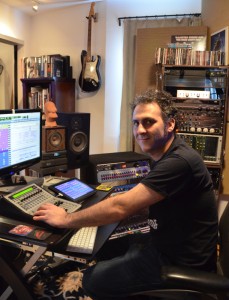
Ben Rubin was determined to kick it up cost effectively — without compromising.
Trying to buy that magic plugin or piece of hardware would have been the easy path, but the Brooklyn-based Rubin didn’t succumb to temptation for his House of Cha Cha. With a credit list that includes Dred Scott Trio, Killah Priest, Karsh Kale, Patti Smith, Courtney Love, Mary J. Blige, Marshall Crenshaw, Moby, Mudville, Alan Cumming, Bill Frisell, Larry Goldings, Louis Hayes, Tom Harrell, Peter Bernstein, Johnny O’Neal, Chris Potter, Emilio Solla, Nicholas Payton, Kurt Rosenwinkel, Roy Hargrove, Eddie Henderson, Mulgrew Miller, Seamus Blake, Cyrille Aimeé, and many more, he had to get it really right.
So how do you keep on top of evolutionary change, and update your sonic feng shui to match up with your modern workflow? Enter Ben’s head to see how he planned it out, and besides the studio overhaul itself, don’t miss his 9 essential tips for saving money while elevating your sound.
Facility Name: House of Cha Cha
Website: http://www.houseofchacha.com, contact -AT- benrubin -DOT- com
Location: Prospect Heights, Brooklyn
What’s good in the Neighborhood: Lots of places for inspiration breaks: Brooklyn Museum, Brooklyn Botanic Garden, Prospect Park, Brooklyn Public Library, Chuko (ramen joint)
Date of Birth: January, 2005
Facility Focus: mixing, tracking overdubs, composition/production
Mission Statement: House of Cha Cha exists to collaborate with artists to create music, from the genre-bending to the pure, that moves butts and brains.
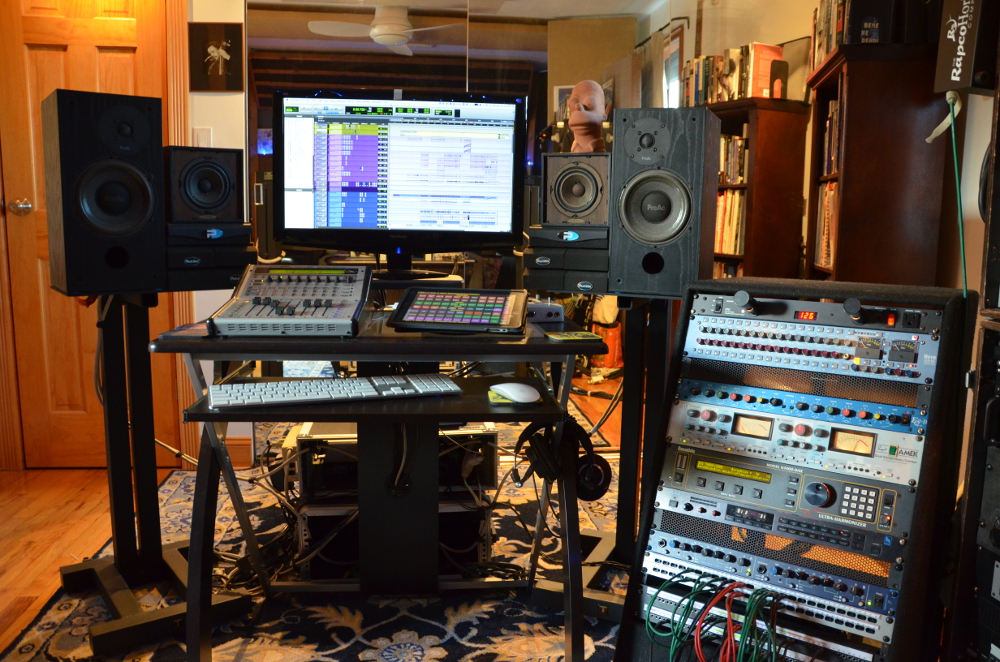
The compact control center post-upgrade — accurate monitoring rule above all else.
Clients/Credits: Ropeadope Records, SmallsLive Records, Someone Else (feature film score), Karsh Kale, Killah Priest, Larry Goldings/Peter Bernstein/Bill Stewart, Tim Ries/Nicholas Payton, Marshall Crenshaw, Emilio Solla, Cyrille Aimée, Harold Mabern, Seamus Blake, Jon Irabagon, Mudville, Dred Scott Trio
Key Personnel: Me, Myself and I
Previous Condition: My old room was small, had minimal treatment and haphazard gear placement as it had evolved over ten years. It was anything but purpose–designed. It was square, almost a cube and, of course, it exhibited all the usual room mode and reflection issues that you would expect from a room like this. Also at this time I was completely ignorant about room acoustics.
In 2005, I was mostly an upright and electric bassist and just starting to learn about producing and mixing records through working with bands I played in like Mudville and the Dred Scott Trio. My first rig was Pro Tools LE 6.9 with a Digi002 and a pair of Genelec 8030As.
Over the next few years I picked up a new client or two every year and producing/mixing became a larger slice of my work life. So my room changed accordingly. It was a slow evolution as I accumulated gear; placement was basically “get in where you fit in.”
In about 2009 or so, I started to oversee the production of the SmallsLive catalog and got more serious about mixing. I replaced my Digi002 with an Avid HD2 rig (with Apogee, Benchmark and Lynx converters) and did some treatment to my room with homemade Corning 703 panels. I was starting to understand that the room itself had a big effect on the sound coming out of my speakers.
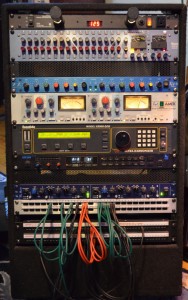
Only gear used within the last year was allowed to remain.
The treatment, as unscientific as its placement was, helped somewhat. While room correction software offered a little further tightening, there was little to be done about the studio’s fundamental acoustic flaws. In 2012, I upgraded to an Avid HD Native card and kept my converters, which is my current rig.
The best thing about the old space was definitely the gear that I’d accumulated (and have mostly retained). I learned early on—from Ken Friesen, the chief engineer at the Tragically Hip’s studio, the Bathhouse—that if you look hard enough and get the right advice, there are great pieces of gear out there that won’t break the bank.
So over time I acquired things like: a Neve 8816 summing amp, a pair of Auratones, an Ampex 351 preamp, an Eventide Harmonizer H3000 D/SE, a Nightpro (aka Maag Audio) EQ3D, an Amek 9098 dual compressor, a pair of Ward Beck 470a preamps/472 EQs, a pair of Telefunken v676 preamps, a Hughes SRS spatializer, a Distressor, a pair of dbx 160Xs, an Ibanez SDR 1000 reverb/delay, an ADR Scamp Rack with awesome S04 parametric EQs and S01 FET compressors. (Full gear list here: http://www.benrubin.com/gear-list/.)
Other than the Neve, most of this gear is (or was at the time) fairly inexpensive. Some of these were really cheap, some maybe a few hundred dollars and some in the low 4 figures. Nothing crazy vintage U47 expensive. Ken also taught me that one way to make your music stand out is to not have the same gear as everyone else. So I try to grow my studio according to Ken’s guidelines.
Evolved Vision: By the time 2015 rolled around, I was really ready for a change. My ears and needs had really outgrown my space. I no longer trusted my Genelecs or the room itself.
Over the past few years, as my creative workflow codified, I realized that I required a space designed specifically for what I was doing, chiefly producing/mixing records and film scoring/co-writing. I needed my most-used gear within arms’ reach, everything in good working order, and easy access to my instruments. The old room was cramped and even playing my bass in there was difficult, let alone getting behind the gear to re-patch or troubleshoot. It came time to build a new space with different monitors and even new furniture, new carpeting.
While my dream is still is to move my studio into an existing facility, with a three-year-old son and another on the way, this was not the time to take on that additional expense. Fortunately there is another, more rectangular room in my apartment that I could use.
From a business standpoint, I knew that if I had a comfortable, great-sounding facility I could attract a wider range of clients. Fitting several people in the old room had been difficult and some bands with whom I was working really needed this. I prefer attended mix sessions, so having more space plus a couch really helps make this possible. Clients regularly walk into the room, think “Wow! I can really work here” and then immediately go for the couch. Further, as my film scoring and co-writing business expanded, easy access to all my instruments to be able to swiftly execute ideas became more important.
Bottom line: I needed a comfortable, cool space conducive to creativity, for both myself and my clients.
Recognizing that my ears (and my taste) are my biggest assets, I knew that the best use of my budget for the new House of Cha Cha would not be to buy lots of new gear or plugins, but to design an existing room to have as accurate as possible monitoring. If I could trust what I was hearing, I knew my ears would always point me in the right direction.
With this in mind, I determined that the best way to improve my studio would be to 1) move to a room with more favorable dimensions, 2) acoustically treat the room as effectively as possible and 3) significantly upgrade my monitoring.
One further caveat: I didn’t really want anything customized just for my new room because I wanted to be able to re-use everything in any subsequent space.
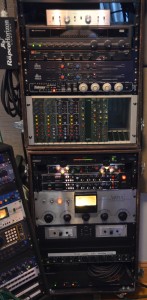
Another rack that was allowed to remain — Rubin puts an emphasis on distinctive gear to hone his own sound.
Affordable Execution: My best decision in terms of both saving money and keeping on schedule was to enlist help in the designing and placement of room treatment, as well as installation, re-cabling, gear modding and gear repair/upkeep. I’ve recently read a ton about room acoustics (there are lots of great online resources) and have a good grasp of the basics, but with limited time and so many options out there, I really needed experienced help.
I was fortunate when a friend introduced me to Amon from Studio Brooklyn. Together, we were able to develop a solid plan for treating the room successfully to the extent possible within my modest mid-four-figure budget. We installed some eight-foot horizontal panels he’d used in his former studio, The Hook, as well as a handful of new ones he built, including some floor-to-ceiling for the back corners, a cloud over the mix position and others for my first reflections points, (including one which converts a gobo.) They not only work great, but look great as well, exuding warmth and calm throughout the room.
We also discussed ideal placement of my older homemade panels as well as where to locate my speakers. Amon was instrumental in helping me recognize and neutralize some of the quirks of my room. Further, through his existing dealer relationships, he was able to get me a great deal on a pair of Sound Anchor monitor stands. Those things are built like tanks and while not cheap, are money well spent since monitoring was my main focus.
Other ways I contain costs include [the 9 tips! — Ed.]: finding gear on eBay, Craigslist, etc.; selling disused gear; bartering; spreading out costs by timing expenses with cash flow and/or 0% interest credit card offers; DIY building; developing good relationships with dealers; modifying existing gear; and keeping studio downtime to a minimum.
To take full advantage of many of these savings while staying on schedule, planning is of utmost importance because the of lead times involved when buying on eBay, timing cash flow and selling or modding gear (especially if someone else is doing it.)
I’m all for DIY but if you’re working with limited time, help can be vital. It’s important to recognize your strengths and weaknesses. I could resolder cables etc, but it would take me forever. Hiring pros saved me lots of hours. (Shout outs to John Charette and Carl Farruggia for doing a bunch of gear maintenance for me and to Kevan Griffin for reconfiguring all of my snakes.)
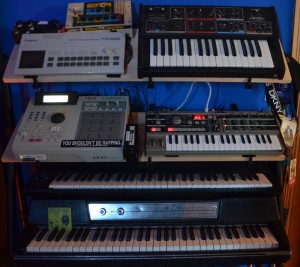
Powerful tower.
Another way to keep costs down is gear modification, either on your own if you have the time and skill, or by sending gear out to one of the well-known guys who do this. This what I did with my power amp and a microphone. I had already bought used ProAc Studio 100s from a friend at a great price. In my never-ending quest to find cool, obscure gear, someone else turned me onto a great power amp, the AdCom GFA-555, which, when brought back up to its original design spec, sounds stunning.
After finding one for cheap on eBay, and having it modded by Jim Williams, I had crafted a killer monitoring setup for a fraction of the price of buying new and/or popular gear.
Recently, I sent my stock Rode NTK to Michael Joly who installed a K47 capsule, among other things, greatly improving this mic and giving it a Neumann U47 flavor. I also just added an EQ bypass switch to my Fender Champ; it’s like having two different amps now.
As part of this process, I also sold a lot of gear and plugins. Anything that I hadn’t used in more than a year had to go. I’ve already mitigated more than a quarter of my costs this way.
AfterMath: Although I have plenty of ideas for further upgrades, I feel like I set a pretty reasonable goal of greatly improving my studio’s overall listening experience, workflow, and vibe.
Though the project came in a little over-budget and took a couple of months longer than I’d expected, it was well worth the wait. The space feels warm and sounds great. Now everything I need is within arms’ reach, and instruments and mics are always set up, ready to go. The room is favorable for recording and there’s even an adjacent tile bathroom, which I can use as an echo chamber.
The reality of the new House of Cha Cha hews pretty close to my original concept and I was pleasantly surprised about how small I could keep the footprint of the desk to make it feel more like I’m just sitting in front of a pair of speakers.
Rave Reviews: I gotta say that it’s really working out great. Now I can easily go from mixing to tracking to writing with ease.
There are certainly still some kinks to work out (like more gear to fix) but it’s really close to done. Clients love to sink into the couch against the back wall and listen deeply. They often report that they’re hearing things in their recording that they didn’t even realize were there!
For writing it’s really easy to plug in a guitar, upright or electric bass, the MPC 2000XL, the Wurly, or VIs and quickly lay down ideas into Pro Tools. While mixing through the Neve 8816, the sound is clear and fat with a much wider and deeper soundstage. I’m hearing details, like reverb, and that bottom octave, as I never could before.
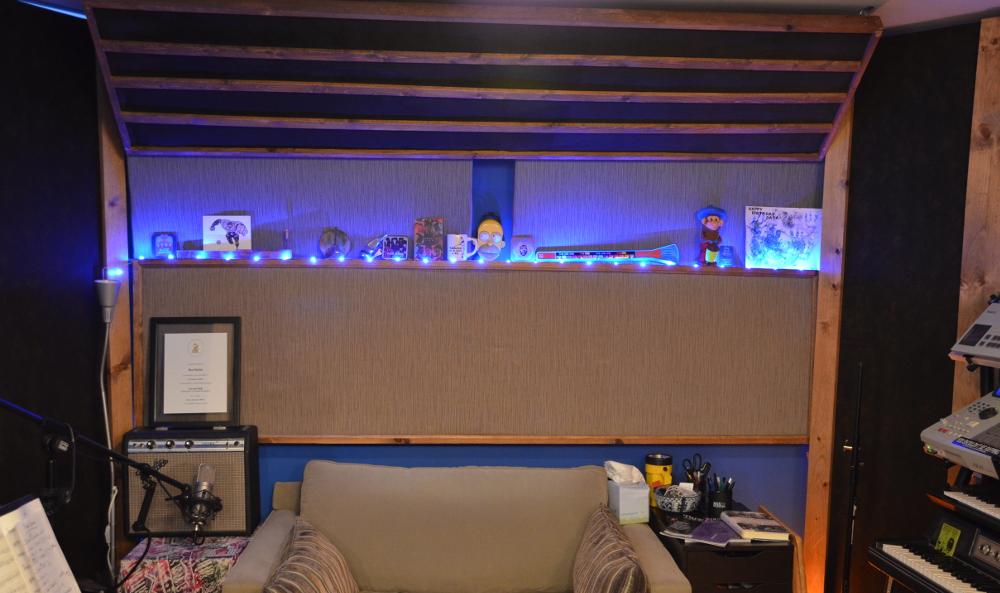
Cha Cha clients can really get comfortable now.
Y’all Come Over Now: Because I’ve worked in so many styles over the years, from purely acoustic to purely electronic to genre-smashing hybrids, I’m really open to everything. I’m looking forward to working on some loud rock ‘n roll, some funk, some hip-hop, some country, as well the jazz and acoustic music that has been my bread-and-butter of late— and mashing them all up into something new whenever I can. Clients love that I’m equally fluent speaking both musician and engineer, and that leads to a trust which often takes the music somewhere unexpected.
I’m also really looking forward to doing more film scoring as well as developing new co-writing relationships. PJ Harvey, I’m ready for you!
- Ben Rubin, Founder House of Cha Cha







Marilyn Carino
February 9, 2016 at 9:01 am (9 years ago)Benny Cha Cha rocks ~~